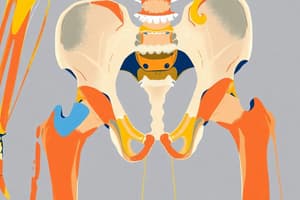Podcast
Questions and Answers
Which ligament limits hip extension?
Which ligament limits hip extension?
- Transverse acetabular
- Iliofemoral (correct)
- Pubofemoral
- Ischiofemoral
What type of joint is the knee joint?
What type of joint is the knee joint?
- Fibrous
- Synovial: hinge (correct)
- Synovial: ball and socket
- Cartilaginous
Which nerve is a sensory and motor nerve innervating the lower limb?
Which nerve is a sensory and motor nerve innervating the lower limb?
- Femoral nerve (correct)
- Saphenous nerve
- Obturator nerve
- Sciatic nerve
Which ligament is intraarticular in the knee joint?
Which ligament is intraarticular in the knee joint?
Which type of movement does the ankle joint allow?
Which type of movement does the ankle joint allow?
Which artery forms Scarpa's triangle or femoral triangle?
Which artery forms Scarpa's triangle or femoral triangle?
What are the articular surfaces of the femoropatellar joint?
What are the articular surfaces of the femoropatellar joint?
Which ligament limits hip flexion?
Which ligament limits hip flexion?
Which nerve is a sensory branch from the femoral nerve?
Which nerve is a sensory branch from the femoral nerve?
What are the main movements allowed by the knee joint?
What are the main movements allowed by the knee joint?
What are the articular surfaces of the femorotibial joint?
What are the articular surfaces of the femorotibial joint?
Which ligament limits hip abduction?
Which ligament limits hip abduction?
What type of joint is the hip joint?
What type of joint is the hip joint?
Which bones fuse to form each pelvic bone?
Which bones fuse to form each pelvic bone?
Which bone is superior in each pelvic bone?
Which bone is superior in each pelvic bone?
What are the articular surfaces of the hip joint?
What are the articular surfaces of the hip joint?
What type of articulation is the hip joint?
What type of articulation is the hip joint?
What is the major function of the lower limb joints?
What is the major function of the lower limb joints?
Which bone forms a synovial articulation with the acetabulum of the pelvic bone?
Which bone forms a synovial articulation with the acetabulum of the pelvic bone?
Which bone is not part of the pelvic bone?
Which bone is not part of the pelvic bone?
Which bone is not part of the lower limb?
Which bone is not part of the lower limb?
Which bone is broadest superiorly?
Which bone is broadest superiorly?
Which joint supports the weight of the body when standing?
Which joint supports the weight of the body when standing?
Which bones form the coxofemoral joint?
Which bones form the coxofemoral joint?
Flashcards are hidden until you start studying
Study Notes
Hip and Pelvis
- The iliolumbar ligament limits hip extension.
- The hip joint is a ball-and-socket type of joint.
Knee Joint
- The knee joint is a hinge type of joint.
- The ligamentum mucosum is intraarticular in the knee joint.
- The main movements allowed by the knee joint are flexion and extension.
Ankle and Lower Limb
- The ankle joint allows dorsiflexion, plantarflexion, inversion, and eversion movements.
- The femoral artery forms Scarpa's triangle or femoral triangle.
- The saphenous nerve is a sensory branch from the femoral nerve.
Joints and Ligaments
- The iliofemoral ligament limits hip flexion.
- The pubofemoral ligament limits hip abduction.
- The articular surfaces of the femoropatellar joint are the patella and the patellar surface of the femur.
- The articular surfaces of the femorotibial joint are the lateral and medial condyles of the femur and the tibia.
Pelvic Bone
- The ilium, ischium, and pubis bones fuse to form each pelvic bone.
- The ilium bone is superior in each pelvic bone.
Hip Joint
- The articular surfaces of the hip joint are the acetabulum of the pelvic bone and the head of the femur.
- The hip joint is a synovial articulation.
- The major function of the lower limb joints is to support the body's weight and facilitate movement.
- The femur bone forms a synovial articulation with the acetabulum of the pelvic bone.
Lower Limb
- The fibula bone is not part of the pelvic bone.
- The tibia bone is not part of the upper limb.
- The ilium bone is broadest superiorly.
- The hip joint supports the weight of the body when standing.
- The coxofemoral joint is formed by the pelvis and femur bones.
Studying That Suits You
Use AI to generate personalized quizzes and flashcards to suit your learning preferences.




